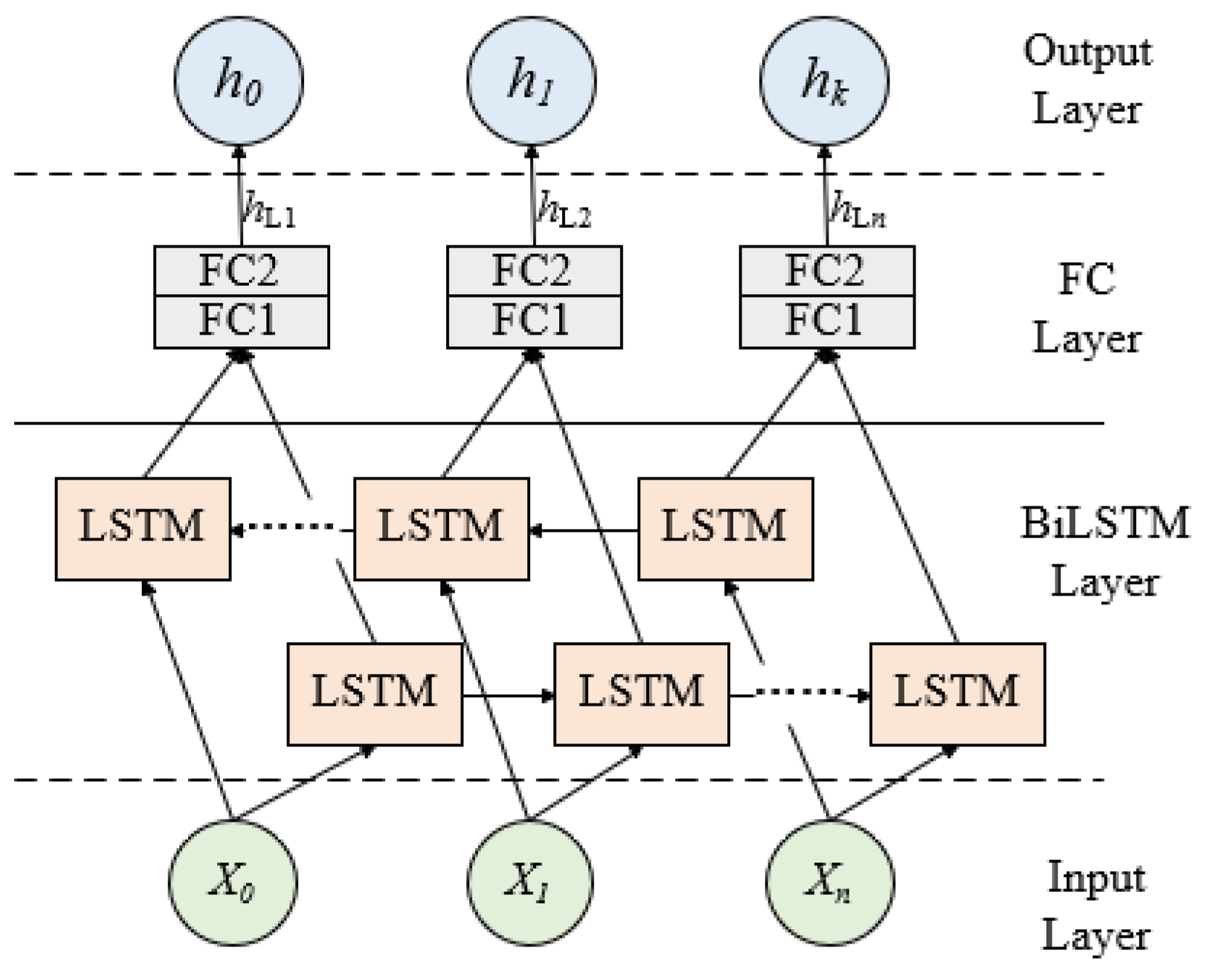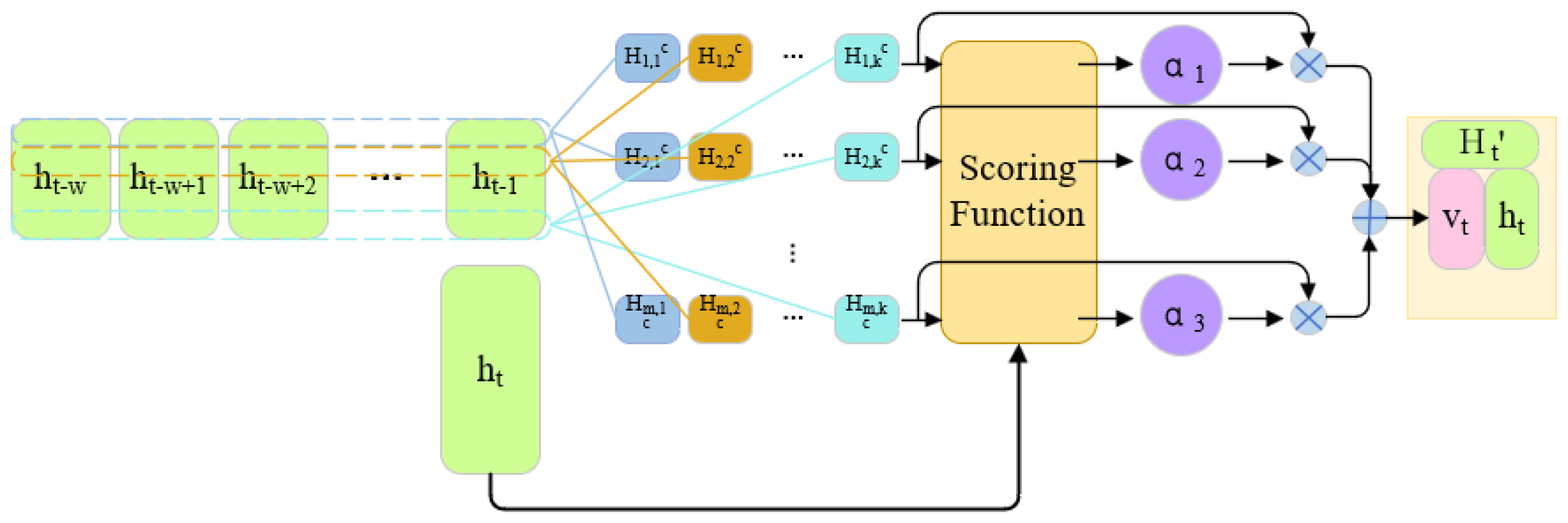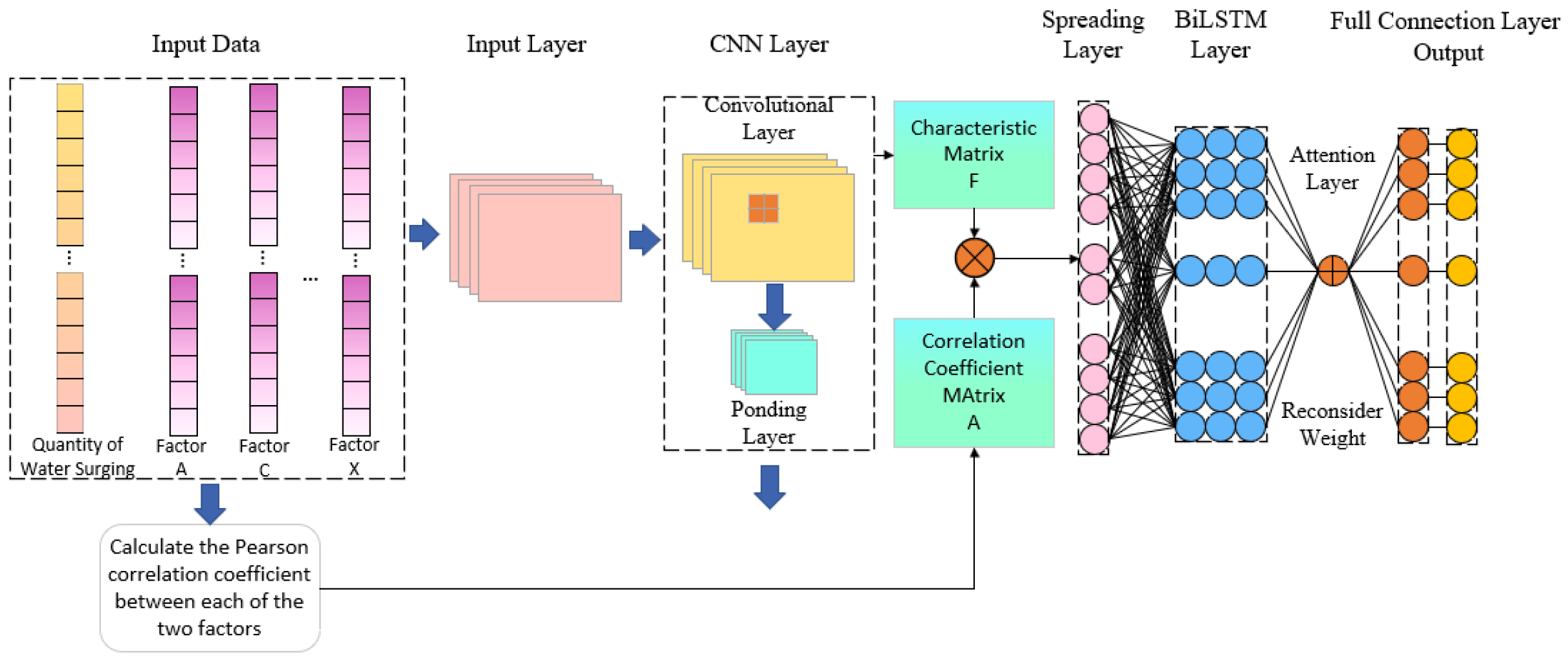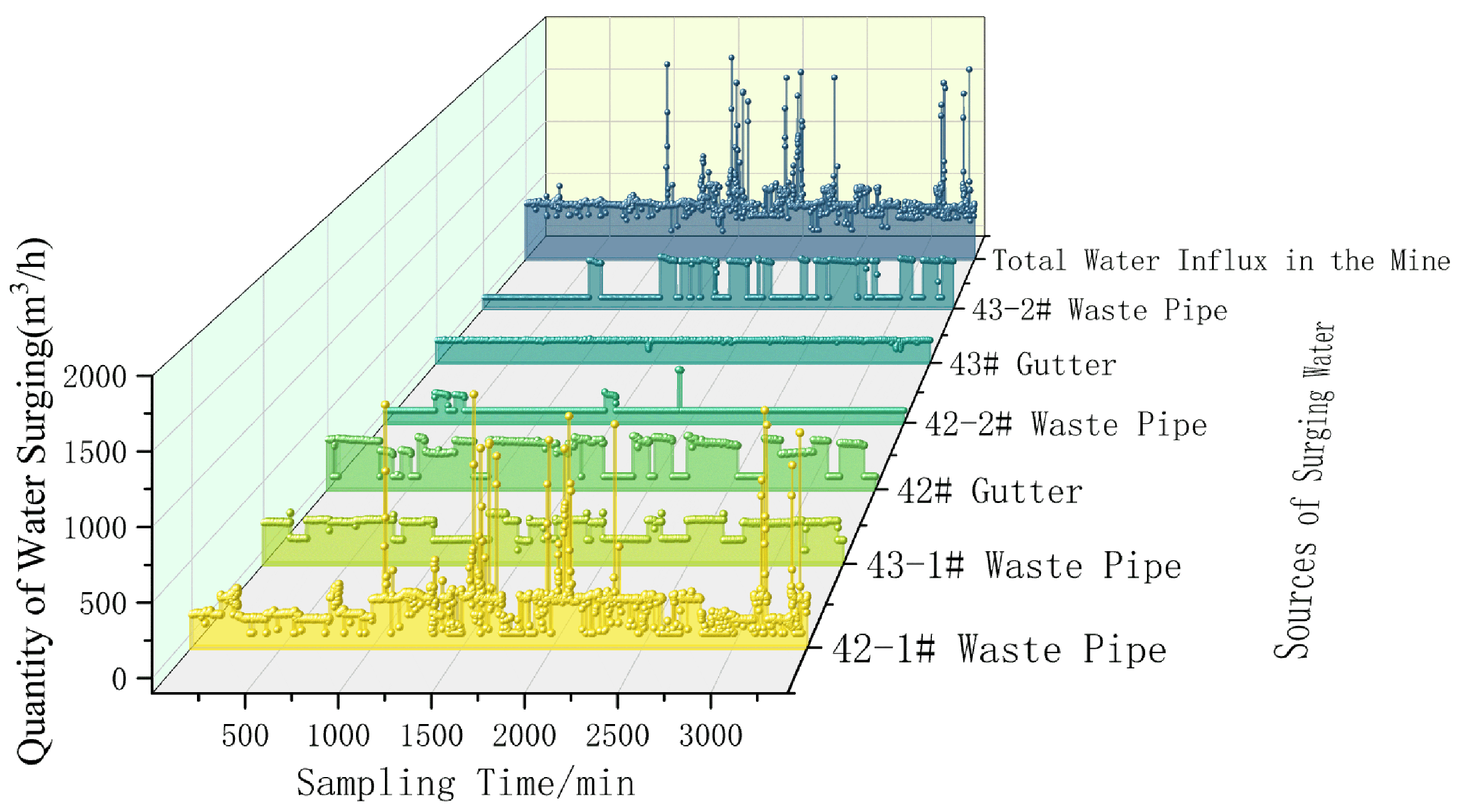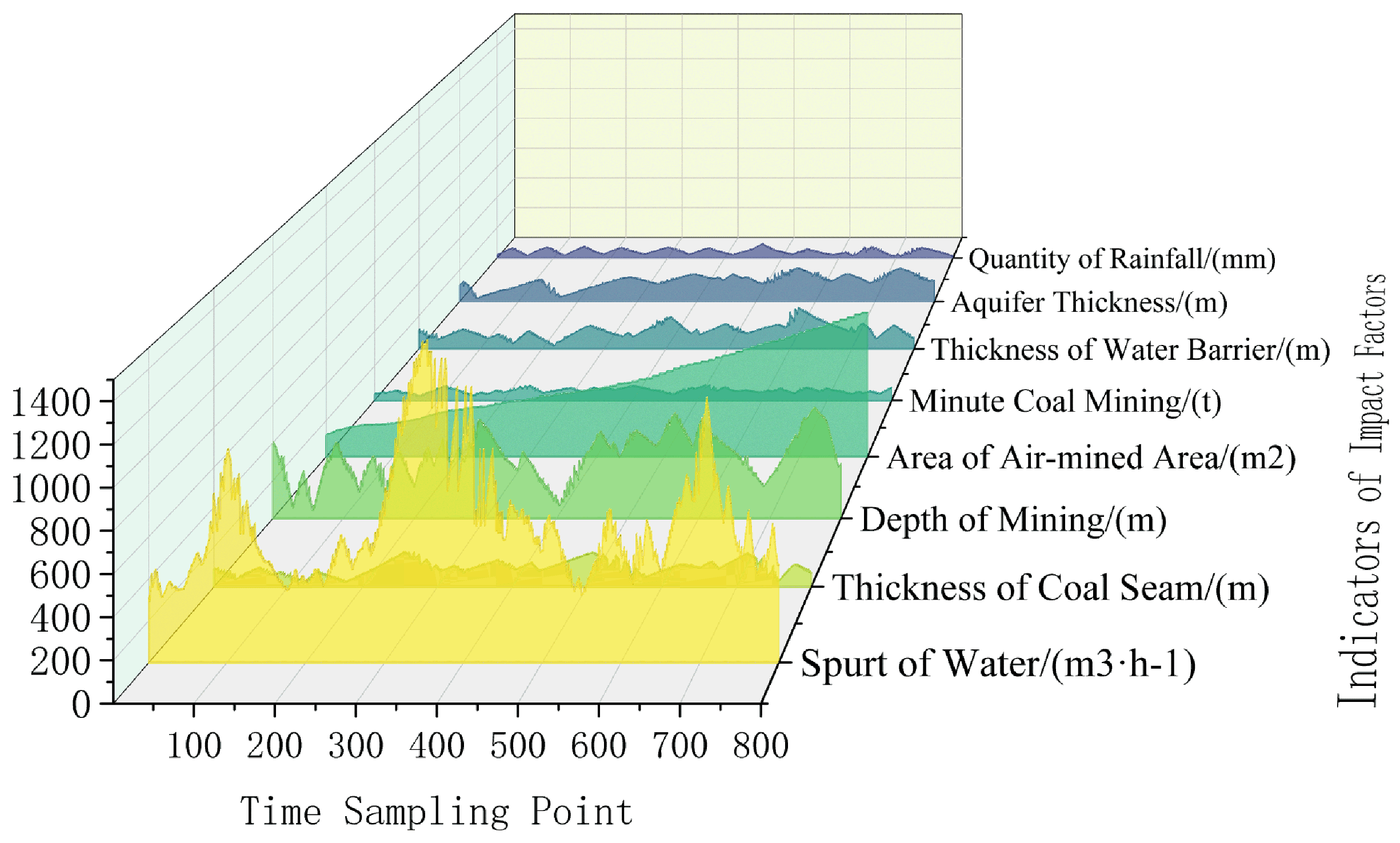1. Introduction
The coal mine water inflow is the key indicator for evaluating coal mine complexity, affecting the economic evaluation of the coal mine. Additionally, the coal mine water inflow is the important basis of developing water prevention and control projects. Therefore, to ensure coal mining safety, predicting coal mine water inflow is necessary. Currently, there are two prediction methods of coal mine water inflow: one is the traditional prediction method based on the stable flow theory, and the other is the modern prediction method based on deep learning, where the magnitude and development trends of coal mine water inflow are predicted [
1,
2,
3,
4,
5,
6,
7,
8]. Dong et al. [
1] developed a coal mine water inflow risk assessment and decision support system based on a Bayesian network. Li et al. [
2] established a water inflow prediction model with geological, hydrogeological, and coal mine conditions. Gu et al. [
3] addressed the limitations of using the water inflow coefficient method to evaluate coal mine water inflow risk, and a comprehensive analysis was conducted. Xie et al. [
4] considered the geological and hydrogeological data of a coal mine and calculated the weights of indicators based on the attribute hierarchy model. Furthermore, some scholars trained models based on data-driven approaches to predict water inflow. Yang et al. [
5] extracted hydrochemical discrimination ions from water samples and proposed an improved water source discrimination model that combined data mining, classification models, and learning reinforcement algorithms. Yin et al. [
6] proposed a data-driven method to predict coal mine water inflow using on-site 3D microseismic monitoring data and demonstrated the effectiveness of the method. Liu et al. [
7] established a water inflow prediction model by predicting the water inflow rate. Yang et al. [
8] proposed a prediction model that utilized microseismic energy density analysis to monitor fracture points within rock layers, providing real-time predictions.
With the development of machine learning algorithms, the long short-term memory (LSTM) network and its improved algorithms achieve good results in time-series prediction in many fields [
9,
10,
11,
12,
13,
14,
15,
16,
17,
18,
19,
20]. Zhang et al. [
9] developed a two-layer LSTM model to predict the depth of the groundwater level, using multiple inputs to predict changes in the groundwater level. Vu et al. [
15] used an LSTM network to fill in missing data of groundwater levels, and retrieved the missing data without the need for calibration. Chen et al. [
16] applied deep learning to the analysis and prediction of coal mine water inflow, which improved the accuracy of water inflow prediction. Gao et al. [
17] used an LSTM network to predict the time series of key water quality indicators, which achieved accurate prediction results. Yang et al. [
19] proposed the DIFF-LSTM model, which effectively stabilized non-stationary water inflow sequences and reduced autocorrelation of the sequences. To predict coal mine water inflow, Shi et al. [
20] added random search and Bayesian optimization algorithms to the LSTM model.
The rapid development of machine learning-based methods enables the relatively accurate prediction of coal mine water inflow. However, the above studies are limited to time-series analyses, without considering the effect of multiple factors on water inflow, including aquifer thickness, coal mining volume per minute, coal seam thickness, goaf area, mining depth, and rainfall. Obviously, coal mine water inflow is affected by the above factors. To improve the accuracy of predicting coal mine water inflow, it is necessary to study the correlation between the above factors and water inflow. Therefore, the present paper develops a coal mine water inflow prediction model based on multi-factor Pearson correlation analysis, where the factors with strong correlations with water inflow are selected to train the prediction model, while the factors with weak correlations with water inflow are neglected to improve the accuracy and efficiency. According to a comparison of the present model with the previous models, the accuracy of predicting coal mine water inflow is improved significantly. The present study is organized as follows. Firstly, the CNN-BiLSTM-Attention model is presented. Next, a Pearson correlation analysis of coal mine water inflow is conducted, where correlation coefficients of different factors are calculated. Then, to validate the performance of the present prediction model, a case study is conducted, where the predicted coal mine water inflow is close to the collected coal mine water inflow. Lastly, the present prediction model is compared to other prediction models; the present prediction model can predict the magnitude and development trends of coal mine water inflow in the next 8 h more accurately.
2. Methods
2.1. Convolutional Neural Network
As shown in
Figure 1, the convolutional neural network (CNN) is composed of a convolutional layer, pooling layer, and fully connected layer. The convolutional layer uses convolutional kernels to perform convolution operations to extract local features of raw data, namely
where
C is the feature to be extracted,
is the activation function,
W is the weight matrix,
X is the input matrix, and
b is the offset. Pooling is achieved by adding a pooling layer after the convolutional layer, whose function is to prevent overfitting. The fully connected layer is used to integrate advanced features learned by the convolutional and pooling layers to obtain the final output. Due to the influence of multiple factors on coal mine water inflow, inputting original data features into time-series prediction models may not help effectively predict water inflow. Therefore, the present paper uses a one-dimensional convolutional neural network to extract deep-level feature data and improve model performance.
2.2. Bidirectional Long Short-Term Memory Network
Due to the fact that a single long short-term memory (LSTM) network can only consider the impact of the preceding sequence data on current data, and cannot provide feedback from subsequent data to the preceding sequence, a variant of LSTM, bidirectional LSTM (BiLSTM), is proposed, which adds a backpropagation layer [
21,
22]. BiLSTM can simultaneously utilize historical data and future information for prediction, improving the predictive ability of the model. As shown in
Figure 2, BiLSTM is composed of an input layer, BiLSTM layer, fully connected (FC) layer, and output layer.
2.3. Attention Mechanism
By focusing on several important local areas, information on time-series prediction is obtained, and a description of time-series features is constructed [
23,
24]. The attention mechanism used is shown in
Figure 3. The features of each time step are extracted to obtain
, representing the state of each feature at each time step, which is input into the scoring function to determine the importance of each indicator at different previous time steps. Different weights are assigned to different parts of the input sequence, and the attention points of the prediction target are obtained to improve prediction accuracy.
2.4. CNN-BiLSTM-Attention Model
As shown in
Figure 4, during the training process, the CNN-BiLSTM-Attention model goes through the following steps: establishing a multi-factor correlation dataset, analyzing the correlation factors of the dataset based on Pearson correlation analysis, and obtaining the correlation coefficient matrix
A. Then, during the convolution feature extraction process, the correlation coefficient matrix is continuously updated. Simultaneously, the dataset is placed in a CNN layer for convolution and pooling operations to extract the feature matrix
F, merge
A and
F and flatten them, input them into BiLSTM for prediction, focus on local features through the attention layer, and reweight them. The propagation mode between
A and
F is
where
A is the correlation coefficient matrix,
I is the identity matrix, and
is the feature matrix of the
i-th layer. Finally, the predicted value is obtained through a fully connected layer. To achieve higher computational speed and ensure prediction accuracy, the number of convolutional and pooling layers in the convolution process is set to 2.
3. Correlation Analysis of Water Inflow
To conduct the present study, water inflow data from Jianxin coal mine, Shaanxi Province, China, is collected to predict coal mine water inflow. Firstly, the mining depth of Jianxin coal mine is close to the aquifer thickness, and the risk of coal mine water inflow is relatively high, making it necessary to predict coal mine water inflow. Secondly, Jianxin coal mine is equipped with a smart coal mine data collection system, making it convenient to collect multi-source data to predict coal mine water inflow, including directly related water inflow data from different zones and indirectly related water inflow data from different environmental factors. The sampling time was from 0:00 on 1 September 2024 to 24:00 on 9 September 2024, and the sampling interval was 3.8 min.
Figure 5 shows directly related water inflow data from different zones, and
Figure 6 shows indirectly related water inflow data from different environmental factors, like aquifer thickness, aquitard thickness, atmospheric temperature, development extension length, goaf area, layer thickness, mining depth, minute coal mining volume, and rainfall. After multi-source water inflow data was collected, we conducted Pearson correlation analysis [
25,
26] to select factors with strong correlations with water inflow to construct the training dataset.
To represent the correlation between environmental factors and water inflow, the Pearson correlation coefficient matrix is calculated. The correlation is divided by 0.2; indicators with a correlation lower than 0.2 are considered unrelated to water inflow. By conducting Pearson correlation analysis, the correlation between environmental factors and water inflow is relatively high, including aquifer thickness, coal seam thickness, mining depth, minute coal mining volume, rainfall, river water level elevation, and temperature, i.e., these environmental factors affect water inflow significantly, so they are selected to construct the dataset to train the water inflow prediction model. The correlation between environmental factors and water inflow is relatively low, including aquitard thickness, development extension length, and goaf area; to achieve higher computational speed and ensure prediction accuracy, they are removed from the training dataset. Based on the Pearson correlation analysis, a multi-factor water inflow prediction dataset is constructed. The dataset consists of three parts: the first part is timestamps, the second part is environmental factors, and the third part is water inflow. The dataset related to water inflow includes directly related data and indirectly related data, like aquifer thickness, coal seam thickness, mining depth, minute coal mining volume, rainfall, river water level elevation, and temperature; 3410 pieces of data related to water inflow are collected for water inflow prediction model training.
4. Case Study
Firstly, the model parameters are introduced. The process batch is set to 12, the number of iterations is 300, the learning rate is set to 0.001, the optimizer is Adam, the input sequence length is 12, and the output sequence length is 6. To validate the accuracy of predicting coal mine water inflow,
Figure 7 shows the predicted coal mine water inflow and collected coal mine water inflow, where the ratio of the training set to the test set is 8:2. The green line is coal mine water inflow data collected by the smart coal mine data collection system, and the blue line is the coal mine water inflow data predicted with the present prediction model. The magnitude and development trend of predicted coal mine water inflow in the next 8 h is close to the collected coal mine water inflow; that is to say, the present prediction model can predict the magnitude and development trends of coal mine water inflow in the next 8 h accurately. Furthermore, the uncertainty of the predicted coal mine water inflow is investigated. The calculation of the uncertainty is as follows. Firstly, calculate the mean value
and standard deviation
s of data points. Then, calculate the standard error
, where
n is the number of data points. Finally, calculate the upper and lower limits of the confidence interval with
. As shown in
Figure 8, the predicted water inflow is close to the collected water inflow. Among 157 data points, most of the data points are within the 95% confidence interval of the predicted water inflow, i.e., the present prediction model can predict the magnitude and development trends of coal mine water inflow in the next 8 h accurately. After the magnitude and development trends of coal mine water inflow in the next 8 h are predicted, to improve coal mining safety management, early warning of coal mine water inflow is made according to detailed rules of coal mine water inflow prevention and control, which are listed in
Table 1. If the risk levels of coal mine water inflow are low or relatively low, coal mining is not affected by water inflow, and water inflow prevention and control are simple. If the risk level of coal mine water inflow is medium, coal mining is affected by water inflow, but it does not threaten coal mining safety. If the risk of coal mine water inflow is relatively high, water inflow is threatening coal mining safety, coal mining is not permitted, people must be evacuated to a safe area, and drainage systems are partly open. If the risk of coal mine water inflow is high, water inflow is seriously threatening coal mining safety, coal mining is not permitted, people must be evacuated to a safe area, and drainage systems are completely open.
To validate the performance of the present prediction model, the evaluation indicators are defined, including mean absolute error (MAE), mean absolute percentage error (MAPE), root mean squared error (RMSE), and correlation coefficient
:
where
is the actual value,
is the predicted value,
is the mean of the predicted values, and
n is the number of the predicted values. Among them, MAE and RMSE are absolute error representations of water inflow, and MAPE is the relative error representation of water inflow. The smaller the above three indicators, the smaller the error between the predicted value and the actual value.
is the degree of fit between the predicted value and actual value; the larger the value of
, the better the degree of fit between the predicted value and actual value.
4.1. Comparative Experiment
To validate the performance of the present prediction model, it is compared to other prediction models, including XGBoost, Random Forest (RF), and KNN, where the model parameters and dataset are the same. As listed in
Table 2, compared to other prediction models, MAE is reduced by 4.174, MAPE is reduced by 0.51, and RMSE is reduced by 4.159, while
is increased by 0.012; this means the present prediction model can predict the magnitude and development trends of coal mine water inflow in the next 8 h more accurately. Under the same model parameters and dataset, the CNN-BiLSTM-Attention model can explore deep information from data related to water inflow; combining data correlation analysis, the present prediction model can predict the magnitude and development trends of coal mine water inflow in the next 8 h more accurately.
4.2. Ablation Experiment
To investigate the effect of the bidirectional long short-term memory network, attention mechanism, and Pearson correlation analysis on the present prediction model, an ablation experiment is conducted, where the model parameters and dataset are the same. As shown in
Table 3, compared to CNN-LSTM, BiLSTM, attention mechanism, and Pearson correlation analysis are helpful for improving the accuracy of predicting coal mine water inflow.BiLSTM provides bidirectional information exchange, the attention mechanism can enhance the level of attention to key parts of time series, and Pearson correlation analysis weights multiple factors related to water inflow; therefore, the CNN-BiLSTM-Attention model based on Pearson correlation analysis can extract accurate features from time-series data, improving the accuracy of predicting coal mine water inflow.
5. Conclusions
A coal mine water inflow prediction model based on multi-factor Pearson correlation analysis is developed, where a convolutional neural network and bidirectional long short-term memory neural network are adopted to extract features from time-series data. To validate the performance of the present prediction model, a case study is conducted. Compared to other prediction models, the present prediction model can predict the magnitude and development trends of coal mine water inflow in the next 8 h more accurately, where the mean absolute percentage error is 5.76% and the correlation coefficient is 0.922, improving coal mining safety management. Meanwhile, an ablation experiment is conducted, where the effect of the bidirectional long short-term memory network, attention mechanism, and Pearson correlation analysis is investigated, demonstrating the advantage of the present prediction model over other prediction models.
Of course, there are some limitations of the present study. Firstly, the present prediction model can only predict overall coal mine water inflow, not local coal mine water inflow. Secondly, based on the collected multi-source dataset, coal mine water inflow in the next 8 h is predicted. If we want to predict water inflow for further hours, the accuracy of predicting water inflow will decrease, since the collected dataset is insufficient. In the future, we will optimize various parameter configurations of the present prediction model, and construct a coal mine water inflow risk warning framework to adapt to water inflow prediction and warnings under actual working conditions.
Author Contributions
Conceptualization, J.H.; Methodology, T.F.; Software, H.Y.; Validation, L.A.; Formal analysis, Z.L.; Resources, W.C.; Writing—original draft, L.M. All authors have read and agreed to the published version of the manuscript.
Funding
The present study is supported by the National Natural Science Foundation of China (42374176), the National Key R&D Program of China (2022YFC3005900), the Open Fund Project of Shaanxi Provincial Key Laboratory of Coal Mine Water Hazard Prevention and Control Technology (2021SKMS07), Fundamental Research Funds for the Central Universities, China University of Geosciences (CUG2642022006) and Open Fund Project of State Key Laboratory of Gas Disaster Detecting, Preventing and Emergency Controlling (2022SKLKF08).
Data Availability Statement
Data will be made available on reasonable request.
Conflicts of Interest
Authors Liang Ma, Zaibing Liu, Tao Fan and Lin An were employed by the company China Coal Science and Industry Xi’an Research Institute Co., Ltd. The remaining authors declare that the research was conducted in the absence of any commercial or financial relationships that could be construed as a potential conflict of interest.
References
- Dong, D.; Sun, W.; Li, H. A decision support system for water inrush in coalmine based on BN (Bayesian network) and GIS. In Proceedings of the 2nd International Conference on Computer Engineering and Technology, Chengdu, China, 16–18 April 2010; Volume 31, p. 172. [Google Scholar] [CrossRef]
- Li, F.; Zheng, J. The prediction and forecast of coal floor water-inrush based on GIS: A case study. In Proceedings of the 2nd Conference on Environmental Science and Information Application Technology, Wuhan, China, 17–18 July 2010; Volume 14, p. 663. [Google Scholar] [CrossRef]
- Gu, Q.; Huang, Z.; Li, S. An approach for water-inrush risk assessment of deep coal seam mining: A case study in Xinlongzhuang coal mine. Environ. Sci. Pollut. Res. 2020, 27, 43163. [Google Scholar] [CrossRef]
- Xie, D. Prediction of the water inrush risk from an overlying separation layer in the thick overburden of a thick coal seam. Sustainability 2023, 15, 13988. [Google Scholar] [CrossRef]
- Yang, Z.; Lv, H.; Wang, X. Classification of Water Source in Coal Mine Based on PCA-GA-ET. Water 2023, 15, 1945. [Google Scholar] [CrossRef]
- Yin, H.; Zhang, G.; Wu, Q. A deep learning-based data-driven approach for predicting mining water inrush from coal seam floor using micro-seismic monitoring data. IEEE Trans. Geosci. Remote Sens. 2023, 61, 1. [Google Scholar] [CrossRef]
- Liu, W.; Ren, Y.; Meng, X. Analysis of Potential Water Inflow Rates at an Underground Coal Mine Using a WOA-CNN-SVM Approach. Water 2024, 16, 813. [Google Scholar] [CrossRef]
- Yang, S.; Lian, H.; Soltanian, M. Hybrid Approach for Early Warning of Mine Water: Energy Density Based Identification of Water-Conducting Channels Combined with Water Inflow Prediction By SA-LSTM. IEEE Trans. Geosci. Remote Sens. 2024, 62, 1. [Google Scholar] [CrossRef]
- Zhang, J.; Zhu, Y.; Zhang, X. Developing a Long Short-Term Memory (LSTM) based model for predicting water table depth in agricultural areas. J. Hydrol. 2018, 561, 918. [Google Scholar] [CrossRef]
- Hua, Y. Deep learning with long short-term memory for time series prediction. IEEE Commun. Mag. 2019, 57, 114. [Google Scholar] [CrossRef]
- Li, Y. EA-LSTM: Evolutionary attention-based LSTM for time series prediction. Knowl.-Based Syst. 2019, 181, 104785. [Google Scholar] [CrossRef]
- Karevan, Z.; Suykens, J. Transductive LSTM for time-series prediction: An application to weather forecasting. Neural Netw. 2020, 125, 1. [Google Scholar] [CrossRef]
- Yadav, A.; Jha, C.; Sharan, A. Optimizing LSTM for time series prediction in Indian stock market. Procedia Comput. Sci. 2020, 167, 2091. [Google Scholar] [CrossRef]
- Benjamin, L.; Timo, M.; Hannes, V. A survey on long short-term memory networks for time series prediction. Procedia CIRP 2021, 99, 650. [Google Scholar] [CrossRef]
- Vu, M. Reconstruction of missing groundwater level data by using Long Short-Term Memory (LSTM) deep neural network. J. Hydrol. 2021, 597, 125776. [Google Scholar] [CrossRef]
- Chen, Y.; Li, Z.; Li, H. Attention-GRU Based Method for Predicting Coal Mine Water Surge Analysis. In Proceedings of the 7th International Conference on Image, Vision and Computing, Xi’an, China, 26–28 July 2022; Volume 1, p. 913. [Google Scholar] [CrossRef]
- Gao, Z. A novel multivariate time series prediction of crucial water quality parameters with Long Short-Term Memory (LSTM) networks. J. Contam. Hydrol. 2023, 259, 104262. [Google Scholar] [CrossRef]
- Wen, X.; Li, W. Time series prediction based on LSTM-attention-LSTM model. IEEE Access 2023, 11, 48322. [Google Scholar] [CrossRef]
- Yang, S.; Lian, H.; Xu, B. Application of robust deep learning models to predict mine water inflow: Implication for groundwater environment management. Sci. Total. Environ. 2023, 871, 162056. [Google Scholar] [CrossRef]
- Shi, J.; Wang, S.; Qu, P. Time series prediction model using LSTM-Transformer neural network for mine water inflow. Sci. Rep. 2024, 14, 18284. [Google Scholar] [CrossRef]
- Chen, W.; He, H.; Liu, J. Photovoltaic power prediction based on sliced bidirectional long short term memory and attention mechanism. Front. Energy Res. 2023, 11, 1123558. [Google Scholar] [CrossRef]
- Wang, Y.; Yao, Y.; Zou, Q. Forecasting a Short-Term Photovoltaic Power Model Based on Improved Snake Optimization, Convolutional Neural Network, and Bidirectional Long Short-Term Memory Network. Sensors 2024, 24, 3897. [Google Scholar] [CrossRef]
- Wang, W.; Zhou, Y.; Shi, B. Recognition Algorithm of Dangerous Goods in Security Inspection Based on Multi-Layer Attention Mechanism. Laser Optoelectron. Progress 2022, 59, 0210011. [Google Scholar] [CrossRef]
- Brauwers, G.; Frasincar, F. A General Survey on Attention Mechanisms in Deep Learning. IEEE Trans. Knowl. Data Eng. 2023, 35, 3279. [Google Scholar] [CrossRef]
- Zhang, M.; Li, W.; Zhang, L. A Pearson correlation-based adaptive variable grouping method for large-scale multi-objective optimization. Inf. Sci. 2023, 639, 118737. [Google Scholar] [CrossRef]
- Wang, X.; Yao, Y.; Li, Z. Protocol Reverse Analysis of Ethernet for Control Automation Technology Based on Sequence Alignment and Pearson Correlation Coefficient. Sensors 2024, 24, 7922. [Google Scholar] [CrossRef]
| Disclaimer/Publisher’s Note: The statements, opinions and data contained in all publications are solely those of the individual author(s) and contributor(s) and not of MDPI and/or the editor(s). MDPI and/or the editor(s) disclaim responsibility for any injury to people or property resulting from any ideas, methods, instructions or products referred to in the content. |
© 2025 by the authors. Licensee MDPI, Basel, Switzerland. This article is an open access article distributed under the terms and conditions of the Creative Commons Attribution (CC BY) license (https://creativecommons.org/licenses/by/4.0/).

